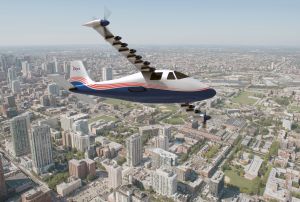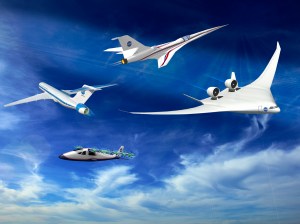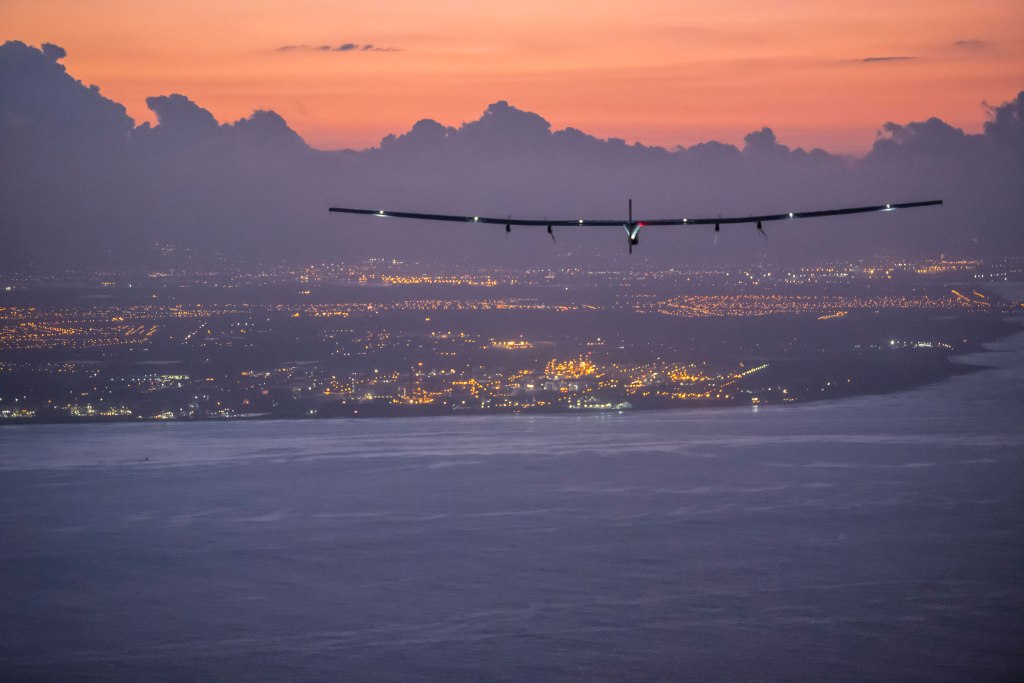The world is on a quest to create cleaner, quieter airplanes that could replace the fuel-guzzling, roaring commercial aircraft in use today.
NASA is leading much of the research and development effort in this area and today they’ve announced an official name for their next X-plane concept: the X-57 “Maxwell.”
Maxwell is a hybrid electric research plane equipped with 14 electric propeller-turning motors located along the wings. The experimental plane will be put through a number of tests over the next four years in an effort to demonstrate that electrical propulsion can make planes quieter, more efficient, and environmentally friendly.
“With the return of piloted X-planes to NASA’s research capabilities – which is a key part of our 10-year-long New Aviation Horizons initiative – the general aviation-sized X-57 will take the first step in opening a new era of aviation.” Charles Bolden, NASA Administrator
During take-off and landing, Maxwell will make use of all 14 motors to create sufficient thrust, but once it’s up in the air it will only use the two larger motors located on the tips of the wings.

NASA engineers believe that this unique design will result in a five-time reduction of the energy required for a small, private planes to cruise at 175 mph.
“NASA researchers working directly with the hybrid electric airplane also chose to name the aircraft “Maxwell” to honor James Clerk Maxwell, the 19th century Scottish physicist who did groundbreaking work in electromagnetism. His importance in contributing to the understanding of physics is rivaled only by Albert Einstein and Isaac Newton” – NASA
Maxwell is a result of NASA’s “New Aviation Horizons” initiative: a 10-year program to create a new generation of X-planes that will make use of greener energy, use half as much fuel, and be half as loud as commercial aircraft in use today. In the President’s FY 2017 budget, NASA received $790 million to fund New Aviation Horizons among other similar green-aviation initiatives.
NASA’s Contribution to Aviation Innovation
While we often think of robots on Mars or astronauts on board the International Space Station when we think of NASA, we shouldn’t forget about that first “A” in the agency’s acronym (National Aeronautics and Space Administration). As I’ve stated in a previous article:
For over 100 years, NASA and its predecessor NACA (the National Advisory Committee for Aeronautics) have used experimental aircraft to advance aviation technology. Through government funds, the agency has reduced the expensive research and development burden on private companies and shortened the time it takes to commercialize new aviation technologies.
Originally known as XS-planes for eXperimental Supersonic and later shortened to simply X, the X-planes are a family of experimental aircraft intended solely for research. Over 56 X-plane concepts have been created and they represent some of the greatest strides in aviation research that NASA has made over the years.

To accomplish the goals set out by New Aviation Horizons, NASA researchers are generating new plane designs and exchanging internal combustion engines that require lead-based aviation fuel with electric motors.
This design change could bring about a number of advantages. Internal combustion engines require bulky, drag-inducing mechanisms for cooling air, combustion air intake, fuel lines, and handling exhaust gases.
In contrast, electrical engines are smaller, less complex, and contain fewer moving parts. For these reasons, electrically powered planes could solve emission problems and, just like electrically powered cars, would be quieter than current commercial alternatives.

However, electrically powered planes require an energy source. Maxwell, for example, will be powered with batteries. Unfortunately, batteries need recharging, and unless you plan to cater your entire airplane design around the use of solar panels, you may only be able to complete short trips.
But, as NASA stated in their press release, Maxwell is designed to be a private plane, which aren’t often optimized for long-haul flights anyway.
Both the weight and storage capacity of batteries on the market today are limiting factors for electric planes, but companies in the automotive industry, like Tesla, are working to change this rather quickly.
Electric aircraft designs have their challenges, but with potentially huge upsides (and mandates from Congress), it’s worth the effort to try to solve them. NASA has a history of propelling the commercial aviation industry forward through fundamental research. With New Aviation Horizons, their hoping to continue that legacy.
An Electrically Powered Future
Electrical airplanes are sure to change the look of aviation, but if humans plan to continue to fly in the future we’ll have to embrace this new era of flight.
According to some reports, the world only contains enough petroleum resources to last us through the year 2100. And as we get closer to that date, fuel prices are likely to rise higher and higher.
Eventually, we’ll need to wean ourselves off of internal combustion engines and the aircraft that use them. To do that, we’ll need to see innovation in aircraft design, battery technology, solar cells and electrically powered engines themselves.
In addition to NASA, companies like Boeing and Airbus, and even other countries have started investing in this future. Planes like the GL-10, Helios, E-Fan, and Solar Impulse have already demonstrated the feasibility of electric planes.
Even Elon Musk has suggested that he has plans to come up with an electrically powered jet. When asked to talk about his “next great idea” Musk responded, “Well I have been thinking about the vertical takeoff and landing electric jet a bit more. I mean, I think I have something that might close. I’m quite tempted to do something about it.”
NASA’s Maxwell is the first X-plane in a decade, but the agency has plans for as many as five more through New Aviation Horizons. The technologies and knowledge gained through this initiative will be passed on to the private sector with the hope that, eventually, electric airplanes will become commonplace and transform flying as we know it.



































Comment